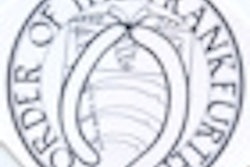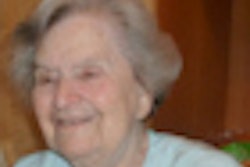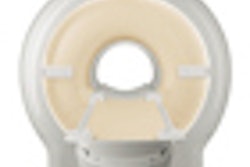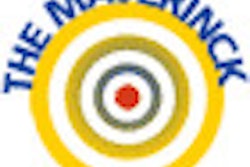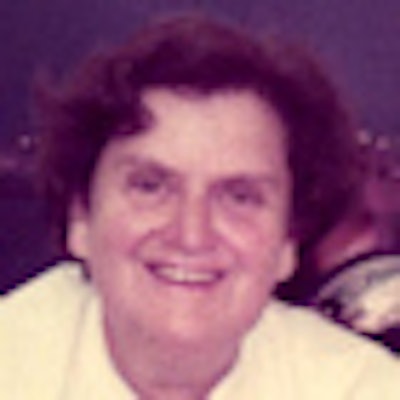
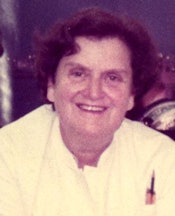 Marion Frank, Hon DSc, an internationally renowned radiographer, died last week.
Marion Frank, Hon DSc, an internationally renowned radiographer, died last week.
Adrienne Finch, past education director, International Society of Radiographers and Radiological Technologists (ISRRT) Europe/Africa
I first met Marion on 21 September 1957, when I started as a student radiographer at The Middlesex Hospital. I was terrified of her, and rarely understood what she said. Her heavily accented English never changed. There was an occasion at a large European meeting, when the interpreter said, in disbelief, "What language is this lady speaking!" Over the next 54 years she became a steadfast supporter of mine and an exceptionally good friend. She was incredibly generous to others and incredibly mean with herself. On her many trips abroad, she always traveled "cattle class," never entertained the idea of taking a taxi -- however much luggage there was -- and some of the hotels she selected were quite unbelievable, but they were cheap!
Even when she retired, she worked incredibly hard. She liked being in control, and only six years ago, still pulling the strings, she set up a working party to write a history of the School of Radiography at Middlesex. However frail she became, she did not stop attending the meetings until the last year, being determined that she should not feature significantly in it. That is an impossible task. The book will be published next year, and it will be dedicated to her and to her radiotherapy colleague Mary Craig.
There are so many wonderful stories about Marion. She told many of them herself. One of them was about being refused the job of working as a cannonball in a circus because she was so fat (she was very short of money at the time). Another was about stoking a boiler at night whilst working during the day because it gave her free accommodation. She spoke of playing poker in 1947 with some sailors on a cargo vessel (traveling steerage) crossing the Atlantic, against the advice of her father, and increasing her investment from 5 pounds to 24 pounds (about 800 pounds, or 920 euros, at current exchange rates).
She once organized a trip to Germany with 50 participants on a charter flight to visit the Deutsches Röntgen Museum, and on the return flight, the aircraft landed at the wrong airfield; Marion was responsible for the landing fees! There is an apocryphal story that she was offered a job at the German delicatessen, Schmidt's, just around the corner from The Middlesex Hospital. Because of her selling skills and knowledge, the owners offered her 1,000 pounds more than her Middlesex salary. She turned them down.
From 1935 to 1990, more than 1,200 pre- and postregistration students were trained in diagnostic and/or radiotherapy radiography, medical ultrasound, and nuclear medicine at The Middlesex Hospital School of Radiography. In addition, 160 international postdiploma students from 50 different counties were trained under Marion's tutelage, 92 of them being employed as teachers in their own countries. Many returned to very senior positions at home. Not only did she look after them academically but socially as well. Of the U.K. radiographers who took the postdiploma course under Marion's tutelage, it was said that the schools of radiography in London and the home counties were like a chess board to Marion; she would already be planning in which school her next newly qualified radiography teachers would be placed before they had even taken their final examination. There is no record of which of her students eventually became examiners for the society and which of them served on the many branch committees and working parties, but no sooner had you finished your examinations than Marion had you "volunteering" for a new role. It was almost impossible to say "no" to her.
Her work rate was incredible. She took on demanding roles at the U.K. Society of Radiographers, including being president in 1967, and was a founding member and officer for many years of the ISRRT (including chair of education for 15 years, organizing six international teachers' seminars, and regional vice president). Along with Kathleen Clark and Evelyn Tyrer, she formulated the ISRRT's first education policy.
Her numerous awards were a measure of the respect with which she was held. She was made an honorary member of the New Zealand Society of Radiographers in 1969, and in 1977 she became an honorary member of special distinction of the Netherlands Society of Radiographers. She was invited by the World Health Organization (WHO) to attend a WHO and International Atomic Energy Authority meeting in 1971 in Tehran to discuss the training of radiographers and other technical staff. In 1977 and 1979, she attended WHO meetings of experts in Brussels and Munich, investigating the efficacy and efficiency of diagnostic applications of radiation and radionuclides. In 1978, she attended the WHO meeting on Technical and Organizational Policy in Radiation Medicine. In 1980, she attended WHO meetings on Consultation on Radiological Services, Needs and Means, and on Quality Assurance in Diagnostic Radiology.
Marion's expertise and knowledge of radiation medicine and radiographic training was world renowned, and in 1978 the Minister of Health in Sudan invited her to Khartoum as an adviser under the auspices of the British Council. A year later, she had a similar invitation from the Zambian government, and she was made an honorary member of the Zambian Radiological Society. In 1980, Marion was made an honorary member of the U.K. Royal College of Radiologists, becoming the first radiographer to receive this honor.
Her hospitality at her flat in London's Lancaster Gate was world renowned. It was the place where her colleagues and friends from all walks of life gathered. Her door was always open. She loved having people to stay, and you never knew who else would be there. On more than one occasion, Marion commented that she was glad there were only two sexes because otherwise organizing her overnight stays would have been so much more difficult.
Many who trained at Middlesex -- whether staff or student -- said that it gave them an excellent training, and Marion's contacts, reputation, and reference stood them in good stead when it came to getting a job. Marion was never afraid of using her influence to get something done when she felt it was right. It was also said that you could not get a job with her unless you could cook and cater and loved food!
The Christmas lunch each year was a major event, and Marion was the inspiration. The lunch was used as a way to thank all those who had helped the school during the year. There could be as many as 100 guests. Turkey, ham, stuffing, roast potatoes, Brussels sprouts, gravy, cranberry sauce, Christmas pudding (steamed in the sterilizer of course), mince pies; everything was produced out of the kitchen on the fourth floor. How no guests were given food poisoning is still a mystery, but the meals were great fun and a superb opportunity to build team spirit.
In 1980, the school celebrated Marion's OBE (Order of the British Empire) award. The event was marked by another "frankfurters-in-the-sterilizer party" and the issuing of the "Order of the Frankfurter" to every participant.
Personally, it is difficult to summarize what I felt about such a complicated person. She was utterly determined, very ambitious for those under her charge, very focused on the job at hand, generous to a fault with time and emotion, and unsympathetic to the foolish and lazy. She inspired enormous love and respect from me and many others.
Dr. Adrian Thomas, chairman, International Society for the History of Radiology, and honorary librarian, British Institute of Radiology
With the death of Marion Frank, the world of radiography has lost a treasure, and I have lost a dear friend. Her contribution to radiography was enormous, and at the world congress of the ISRRT in September 2010, Marion was given the Dien Van Dijk Award for services to international radiography. Unfortunately, by this time she was already ill, and it was a personal privilege to be able to present her with the award at her flat in Lancaster Gate in London. Characteristically, she said that she did not deserve the award.
Marion had to leave Germany in 1937 while her family left in 1939; they ended up in England. This was not an easy time for Europe. Her brother George joined the army and was killed on D-Day as he came off his landing craft. Marion and her twin sister were both working at the Royal Northern Hospital in London when they encountered radiographer Kathleen Clara Clark, who persuaded them to enter radiography. Marion recounted that they used Clark's classic work Positioning in Radiography to replace the missing third leg of a wardrobe!
Marion progressed rapidly in radiography, working at Putney hospital, then at Stoke, becoming a full-time teacher; in 1949 she was appointed as superintendent radiographer and principal at The Middlesex Hospital. Three pieces of advice that Marion would give are that you cannot change your personality, that you must aim high if you want to get on professionally, and that you must offer something in addition that someone else cannot do. She had a wonderful time at The Middlesex Hospital. She became president of the U.K. Society of Radiographers and said that she enjoyed herself and that her main role was communication.
Marion became very interested in world radiography, and with Kathleen Clark, was involved in the foundation of the ISRRT. Her hospitality was legendary. The door of her flat was always open to visiting radiographers, and her spare bed was in constant use. Marion had many interests and was active in the British Institute of Radiology, the Osler Club of London, and the British Society for the History of Radiology. She loved the Deutsches Röntgen Museum in Remscheid Lennep, Germany, and took many students there for visits.
Marion enjoyed life and her enthusiasm was contagious. Radiography was her life, but her heart belonged to the Deutsches Röntgen Museum and to The Middlesex Hospital. "I have never been a good radiographer, but I knew how to get out of trouble," she said. The regret of her final years was that she could not make that final visit to the museum that she loved so dearly.
I will miss her, as will many others.
Gunvor Robertsen, supervising radiographer - MRI, St. Olav University Hospital, Trondheim, Norway
In May 1982, just before we graduated as radiographers in Norway, our group of seven students came to London for a week to visit radiology departments and radiographer students. At The Middlesex Hospital, we were welcomed by a very enthusiastic Marion Frank. After a long day at "her" department and school, she invited us for a cup of tea in her home. She rounded us all up into her tiny car, and we (miraculously) arrived safely at her home, where we had an unforgettable time.
In Norway at that time, staff at x-ray departments received an extra week of vacation per year, to "recover" from the risks involved of working with x-rays. We had learned that this concession was about to be canceled, but only for those who were employed after June 1982. How very unfair, we thought! As students, we had learned about the hazards involved, but also of how to act to prevent excessive radiation to both patients and staff.
Marion was very eager to discuss the differences between education in Norway and the U.K. She argued that if we were properly educated, we didn't need an extra week because we knew why, when, and how much radiation would be needed. We should be confident in our education, and practice our knowledge through professional challenges and conduct. Within a year, the "x-ray week" was history. We all accepted the argument that Marion stated so well, and I believe we all have respected her joy of working within the world of x-ray imaging and radiotherapy.
As a previous council member of the ISRRT, I had the privilege to see the impact of Marion's passion for our profession, and how she encouraged people to keep working for radiography and healthcare development worldwide. In May 2008, I was invited back for a cup of tea in her home. She was older in years, but still had the strong and lively mind that I had admired many years before.
A respected pioneer will be missed.




